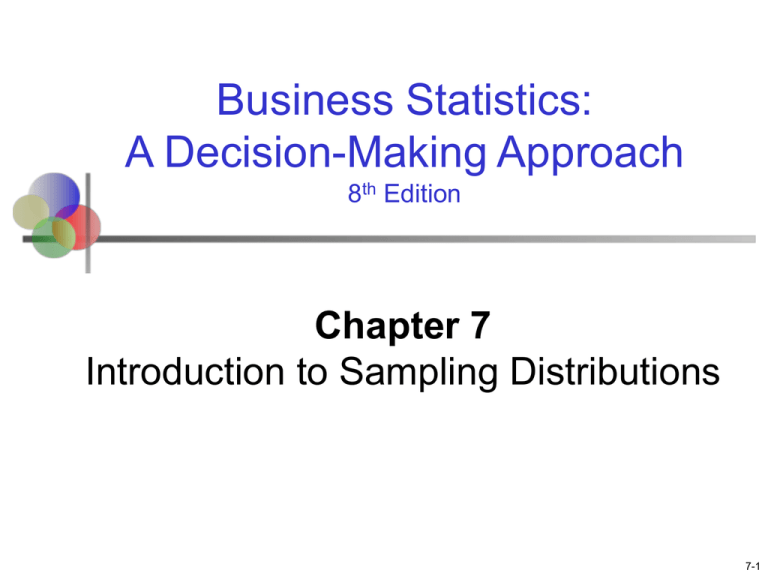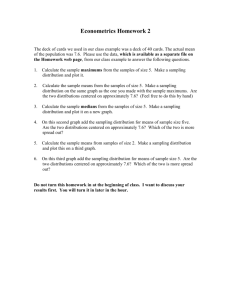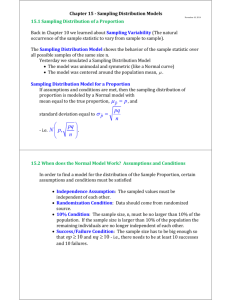
Business Statistics:
A Decision-Making Approach
8th Edition
Chapter 7
Introduction to Sampling Distributions
7-1
Chapter Goals
After completing this chapter, you should be
able to:
Define the concept of sampling error
Determine the mean and standard deviation
_ for the
sampling distribution of the sample mean, x
Determine the mean and standard deviation for the
_
sampling distribution of the sample proportion, p
Describe the Central Limit Theorem and its importance
_
_
Apply sampling distributions for both x and p
7-2
Sampling Error
Sample Statistics are used to estimate
Population Parameters
ex: X is an estimate of the population mean, μ
Problems:
Different samples provide different estimates of the
population parameter
Sample results have potential variability, thus sampling
error exits
7-3
Calculating Sampling Error
Sampling Error:
The difference between a value (a statistic)
computed from a sample and the corresponding
value (a parameter) computed from a population
Example: (for the mean)
Sampling Error x - μ
where:
x sample mean
μ population mean
Always present
just because
you sample!
7-4
Example
If the population mean is μ = 98.6 degrees
and a sample of n = 5 temperatures yields a
sample mean of x = 99.2 degrees, then the
sampling error is
x μ 99.2 98.6 0.6 degrees
7-5
Sampling Errors
The sampling error may be positive or negative
( x may be greater than or less than μ)
The size of the error depends on the sample selected
i.e., a larger sample does not necessarily produce a smaller
error if it is not a representative sample
Download “Sampling Distributions using Excel”
First sheet: “Sampling Error”
7-6
Sampling Distribution
A sampling distribution is a distribution of all
possible values of a statistic for a given
sample size that has been randomly selected
from a population.
Download “Sampling Distributions using Excel”
Second sheet: “Sampling Dist”
7-7
Sampling Distribution Properties
For any population,
The average value of all possible sample means
computed from all possible random samples of a
given size from the population is equal to the
population mean (call “Unbiased Estimator”):
See “Sampling Distributions using Excel”
Considered an
“unbiased” estimator
μx μ
Theorem 1
7-8
Sampling Distribution Properties
(continued)
The standard deviation of the possible sample means
computed from all random samples of size n is equal to
the population standard deviation divided by the square
root of the sample size (call Standard Error):
Try using “Sampling Distributions using Excel” Not Equal!
Also called the
standard error
σ
σx
n
Theorem 2
7-9
Finite Population Correction
Virtually all survey research, sampling is conducted
without replacement from populations that are of a
finite size N.
In these cases, particularly when the sample size n is
not small in comparison with the population size N (i.e.,
more than 5% of the population is sampled)
so that n/N > 0.05, a finite population correction
factor (fpc) is used to define both the standard error of
the mean and the standard error of the proportion.
7-10
Impact of fpc by Sample Size
7-11
Finite Population Correction
Apply the Finite Population Correction (fpc) if:
The sample size is greater than 5% of population size.
Only with sampling without replacement
Then
(x μ)
z
σ Nn
n N 1
See fpc by “Sampling Distributions using Excel”
7-12
Sampling Distribution Properties
(continued)
As the sample size is increased, the StdDev of
the sampling distribution is reduced…..
That is, the potential for extreme sampling error
is reduced when larger sample size are used.
Graphical illustration: next slide
7-13
Sampling Distribution Properties
(continued)
The value of
increases):
x becomes closer to μ as n
Population
x
Small
sample size
As n increases,
x
σ x σ/ n decreases
Larger
sample size
μ
x
7-14
If the Population is Normal
If a population is normal with mean μ and
standard deviation σ, the sampling distribution
of
x
is also normally distributed with
μx μ
and
σ
σx
n
Theorem 3
As n increases the data behaves more like a normal distribution
7-15
z-value for Sampling Distribution
of x
z-value for the sampling distribution of
x:
(x μ)
z
σ
n
where:
x = sample mean
μ = population mean
σ = population standard deviation
n = sample size
7-16
Example
Suppose that a population is known to be normally
distributed with μ = 2,000 and σ = 230 and random
sample of size n = 8 is selected.
Because the population is normally distributed, the sampling
distribution for the mean will also be normally distributed.
What is the probability that the sample mean will
exceed 2,100?
Convert to Z value
Using Excel: 1-NORMSDIST(1.23)
Answer on the website
7-17
If the Population is not Normal
We can apply the Central Limit Theorem:
Even if the population is not normal,
…sample means from the population will be
approximately normal as long as the sample size is
large enough
…and the sampling distribution will have
μx μ
and
σ
σx
n
Theorem 4
7-18
Central Limit Theorem
If necessary, watch the Video
As the
sample
size gets
large
enough…
n↑
the sampling
distribution
becomes
almost normal
regardless of
shape of
population
x
7-19
How Large is Large Enough?
For most distributions, n > 30 will give a
sampling distribution that is nearly normal
For fairly symmetric distributions, n > 15 is
sufficient
For normal population distributions, the sampling
distribution of the mean is always normally
distributed
7-20
Example
Suppose a population (not normally distributed) has
mean μ = 8 and standard deviation σ = 3 and
random sample of size n = 36 (greater than 30) is
selected.
What is the probability that the sample mean is
between 7.8 and 8.2?
7-21
Example
(continued)
Solution (continued) -- find z-scores:
μ
μ
7.8 - 8
8.2 - 8
x
P(7.8 μ x 8.2) P
3
σ
3
36
n
36
P(-0.4 z 0.4) 0.3108
Population
Distribution
???
?
??
?
?
?
?
?
μ8
Sampling
Distribution
Standard Normal
Distribution
Sample
0.1554
+0.1554
Standardize
?
x
7.8
μx 8
8.2
x
-0.4
μz 0
0.4
z
7-22
Sampling Distribution of a Proportion
Try this by yourself!
In many instances, the objective of sample is to
estimate a population proportion.
An accountant may be interested in determining the proportion
of accounts payable balances that are correct.
A production supervisor may wish to determine the percentage
of product that is defect free.
A marketing research department might want to know the
proportion of potential customers who will purchase a prticular
product.
7-23
Population Proportions Example
If the true proportion of voters who support Proposition
A is π (population proportion) = 0.4, what is the probability
that a sample of size 200 yields a sample proportion
between 0.40 and 0.45?
i.e.: if π = 0.4 and n = 200, what is
P(0.40 ≤ p ≤ 0.45) ?
7-24
Example
(continued)
if π = .4 and n = 200, what is
P(0.40 ≤ p ≤ 0.45) ?
Find σ p : σ p
π(1 π)
.4(1 0.4)
0
0.03464
n
200
Convert to
P(0.40 p 0.45)
standard
normal
(z-values):
0.45 0.40
0.40 0.40
P 0
z0
.03464
.03464
P(0 z 1.44)
7-25
Example
(continued)
if π = 0.4 and n = 200, what is
P(0.40 ≤ p ≤ 0.45) ?
Use standard normal table:
P(0 ≤ z ≤ 1.44) = 0.4251
Standardized
Normal Distribution
Sampling Distribution
0.4251
Standardize
0.40
0.45
p
0
1.44
z
7-26
Population Proportions, π
π = the proportion of the population having
some characteristic
Sample proportion ( p ) provides an estimate
of π :
x
number of successes in the sample
p
n
sample size
If two outcomes, p is a binomial distribution
7-27
Sampling Distribution of p
Approximated by a
normal distribution if:
Sampling Distribution
.3
.2
.1
0
nπ 5
n(1 π) 5
0
where
μp π
P( p )
and
.2
.4
.6
π(1 π)
σp
n
8
1
p
Theorem 5
(where π = population proportion)
7-28
z-Value for Proportions
Standardize p to a z value with the formula:
pπ
z
σp
If sampling is without replacement
and n is greater than 5% of the
population size, then σ p must use
the finite population correction
factor:
pπ
π(1 π)
n
σp
π(1 π) N n
n
N 1
7-29
Using the Sample Distribution for
Proportions
1. Determine the population proportion, p
2. Calculate the sample proportion, p
3. Derive the mean and standard deviation of the
sampling distribution
4. Define the event of interest
5. If np and n(1-p) are both > 5, then covert p to
z-value
6. Use standard normal table (Appendix D) to
determine the probability
7-30
Chapter Summary
Discussed sampling error
Introduced sampling distributions
Described the sampling distribution of the mean
For normal populations
Using the Central Limit Theorem (normality unknown)
Described the sampling distribution of a
proportion
Calculated probabilities using sampling
distributions
Discussed sampling from finite populations
7-31
All rights reserved. No part of this publication may be reproduced, stored in a retrieval
system, or transmitted, in any form or by any means, electronic, mechanical, photocopying,
recording, or otherwise, without the prior written permission of the publisher.
Printed in the United States of America.
7-32










